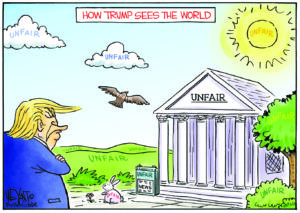Purpose and Predictability
"Lions for Lambs" is certainly an ambitious movie. It features an ambitious starring lineup, and it plays on ambitious and timely themes: America at war in Iraq and Afghanistan, post-9/11 media complacency and individual responsibility in morally ambiguous situations. Too bad it's just not a very good movie.
“Lions for Lambs” is certainly an ambitious movie. First of all, it features the ambitious starring lineup of Robert Redford, Meryl Streep and Tom Cruise, whose distinctive faces gaze out of the film’s black-and-white promotional posters with gravitas and purpose. (Indeed, purpose is the key term in this big-screen morality tale, if you couldn’t tell from its hortatory tag line: “If you don’t stand for something, you might fall for anything.”)
Plus, Redford flexes his talents behind the camera as the drama’s director, taking on some seriously ambitious material in this timely story about, on the broadest level, contemporary America at war in Iraq and Afghanistan. On the level of character, it’s about making meaningful life decisions in situations that don’t exactly offer flashing lights to point the way to heroism, success or even basic survival.
With all these potent ingredients in the mix, it’s too bad that “Lions for Lambs” just isn’t a very good movie.
“Lambs” opens with an American television report blaring the latest news about the Iraq war and quickly sets up the three main narratives braided together throughout the film. We meet Todd Hayes, a disaffected yet promising student (played by Andrew Garfield) at a generic California university, who’s called in by his political science professor, Vietnam veteran Stephen “Doc” Malley (Redford), for a gauntlet-throwing meeting about Todd’s spotty attendance and gradual disengagement from a course he once galvanized with the kind of in-class displays of civil disobedience that aspiring academics only dream about before their “O Captain! My Captain!” fantasies give way to “publish or perish” realities.
We also watch Janine Roth (Streep), once a hard-hitting Washington journalist, as she unwittingly steps into an exclusive interview with slick Sen. Jasper Irving (Cruise), the same Republican wunderkind she talked up in a flattering national magazine piece years before, when her high-profile mainstream media affiliation seemed more like an asset than a liability. No slouch when it comes to working the press to his advantage, Irving tells Roth he’s looking to repay her favor with a big scoop about America’s troops in the “war against terror.”
Sen. Irving’s hard sell initially seems to hit its mark as, despite her verbal jousting skills and her zingers about President George W. Bush’s diplomatic disasters since 9/11, Roth can’t fully disguise her susceptibility to Irving’s polished rhetoric. She’s at least momentarily held captive on the senator’s turf, surrounded by his (awkwardly Photoshopped) career-highlight snapshots with Bush II, Condoleezza Rice and Dick Cheney — as though Irving’s tailored waistcoat, practiced talking points and glad-handing official credentials weren’t sufficiently obvious indicators of his vaunted position within this particular administration.
Irving tells Roth of a new U.S. military combat tactic, which bears more than a passing resemblance to a strategy she critiqued as a budding journalist covering the Vietnam War. Roth is spooked by Irving’s performance but maintains a measure of composure, filling her reporter’s notebook with jibberish during their hour-long session, except for one telling phrase she earmarks as the most important take-away about his party’s future intentions: “Whatever it takes.”
The thread pulling these seemingly disparate story lines together plays out in the brothers-in-arms subplot about Arian Finch (Derek Luke) and Ernest Rodriguez (Michael Peña), an African American soldier and a Latino soldier, respectively. As “Doc” tells Todd during their heart-to-heart session, Finch and Rodriguez were once hard-working students who had learned a thing or two from the school of hard knocks, and yet, to their mentor’s chagrin, they both decided to ship out to Afghanistan as members of the U.S. military special forces, arguing that their future prospects would only be enhanced by their sacrifice, should they survive their tours of duty. Their scenes are clearly designed for maximum emotional effect, drawing on flashbacks to their impassioned testimonies in Doc’s class to add weight to their dramatic denouement — which at once comes closest to hitting the story’s sweet spot and underscores the film’s failure to make good on its initial promise. (This shortcoming isn’t at all helped by the fact that Finch and Rodriguez are unceremoniously plopped down in a rather goofy setting for the bulk of their most compelling scenes, on an Afghan mountaintop dusted with faux snow and overrun by shadowy Taliban figures in the background.)
Sure, it’s easy to sniff at a Hollywood production aiming to make a coherent point about an ongoing and complex conflict that’s still playing out on the world stage, with no signs of resolution soon and no shortage of fresh horror appearing in headlines and on screens of all sizes every day. After all, given filmmaking conventions and production timelines, the odds are stacked against any dramatization of current events achieving some semblance of intelligibility within 88 minutes of footage cobbled together to form a finished product long before reality could easily make a mockery of its driving premise.
All the same, anyone who plunks down the $10 or so required to take in a film like “Lions for Lambs” these days might be looking for this kind of movie to offer some insights that she or he couldn’t find by switching on the nightly news or surfing the Internet. And this fall’s Hollywood films that attempt to deal with battles abroad and at home — “In the Valley of Elah,” “Rendition” and now “Lions for Lambs,” to name the main headline-grabbers — carry a particular burden because of their subject matter and the timing of their release.
But do they deliver? In the case of “Lions for Lambs” — the first offering from the newly resuscitated United Artists studio — the answer is no. Redford, Sundance’s patron saint, can’t make his character into anything more than a shopworn figure we’ve all seen many times before. Nor can actress extraordinaire Streep, who gets by here by pretending she’s taking part in a much more interesting movie, adding some amusing quirks for no apparent reason. The only actor who seems well suited for his appointed role is Cruise, all set of jaw and flared of nostril, assuredly creepy in a way that adds to his character’s credibility.
Ultimately, the combined star power of these top-billers isn’t enough to draw moviegoers into theaters. By the time the closing credits of “Lions for Lambs” roll, audience members who hoped for an enriching experience are likely to be feeling as in the dark as they were when the lights first went down. Big stars and a big story add up here to a big movie that treads a predictable path at a time when we could really use original and effective stories about the state of our world — no matter where they come from.
Your support matters…Independent journalism is under threat and overshadowed by heavily funded mainstream media.
You can help level the playing field. Become a member.
Your tax-deductible contribution keeps us digging beneath the headlines to give you thought-provoking, investigative reporting and analysis that unearths what's really happening- without compromise.
Give today to support our courageous, independent journalists.






You need to be a supporter to comment.
There are currently no responses to this article.
Be the first to respond.